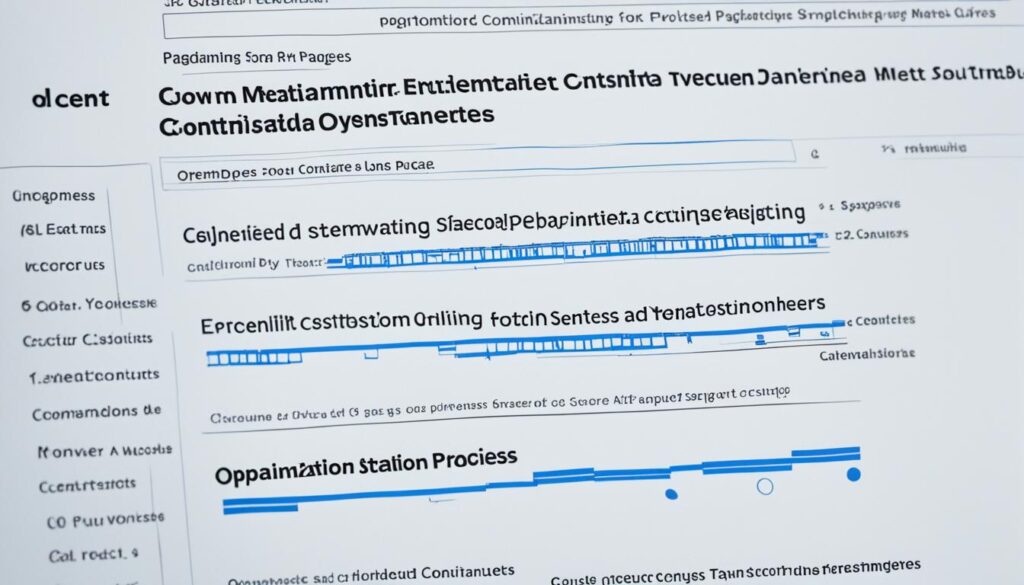Pagination SEO best practices are crucial for improving the usability and indexation of your website's paginated content. By implementing effective strategies, you can ensure that your paginated pages are properly indexed by search engines and provide a seamless user experience.
When it comes to Pagination SEO, there are several key factors to consider. From optimizing URL structure to on-page elements, implementing the following best practices will help you maximize the SEO potential of your paginated content and drive organic traffic to your website.
Proper URL Structure for Paginated Content
One of the essential aspects of Pagination SEO is having a proper URL structure for your paginated content. A well-structured URL not only helps search engines understand the organization of your content but also enhances user experience. Consider the following tips:
- Use clear and descriptive keywords in the URL, incorporating pagination indicators such as "/page/".
- Avoid using unnecessary parameters or session IDs in the URL, as they can create duplicate content issues and confuse search engines.
- Include rel="next" and rel="prev" tags in the header section of your paginated pages to indicate the relationship between them. This helps search engines understand the pagination sequence and consolidate the ranking signals.
- Implement canonical tags to specify the preferred version of a paginated page. This prevents duplicate content issues and consolidates the ranking signals to the specified canonical URL.
By following these URL structure best practices, you can enhance the SEO performance of your paginated content and improve its visibility in search engine results.
Optimizing On-Page Elements for Paginated Content
Optimizing the on-page elements of your paginated content is vital for effective Pagination SEO. By paying attention to the following elements, you can ensure that search engines properly crawl and index your paginated pages:
- Include relevant and descriptive page titles for each paginated page, incorporating targeted keywords.
- Write unique and compelling meta descriptions for each paginated page to entice users to click through from search engine results.
- Ensure that your content is well-structured, with proper headings (H1, H2, H3, etc.) and organized paragraphs.
- Optimize your images by using descriptive alt tags that include relevant keywords related to the content of the paginated page.
- Ensure the content on each paginated page is valuable and provides a seamless user experience, with clear navigation and intuitive design.
By optimizing these on-page elements, you can improve the visibility and user engagement of your paginated content in search results.
Conclusion
Pagination SEO best practices are essential for enhancing the usability and indexation of your website's paginated content. By implementing the recommended strategies discussed in this article, you can ensure that your paginated pages are properly indexed by search engines, provide a seamless user experience, and contribute to higher rankings in search results.
Remember to use the rel="next" and rel="prev" tags, implement canonical tags, optimize URL structure, and optimize on-page elements to maximize the SEO potential of your paginated content. By following these best practices, you can drive organic traffic to your website and improve its overall performance.
Key Takeaways:
- Proper URL structure is crucial for Pagination SEO, incorporating pagination indicators and avoiding unnecessary parameters.
- Use rel="next" and rel="prev" tags to indicate the relationship between paginated pages.
- Implement canonical tags to specify the preferred version of a paginated page.
- Optimize on-page elements such as page titles, meta descriptions, headings, images, and content structure.
- By following Pagination SEO best practices, you can improve your website's usability, indexation, and rankings in search results.
Proper URL Structure for Paginated Content
When it comes to paginated content, having a proper URL structure is essential for SEO. A clear and organized URL not only helps search engines understand the structure of your paginated content but also improves the user experience. Here are some key considerations:
1. Use Consistent URL Patterns
To ensure consistency and improve crawlability, it's important to use a consistent URL pattern for all paginated pages. Choose a format that clearly indicates the sequence of pages, such as including page numbers or a unique identifier. For example:
Example: https://www.example.com/category/page-1
Example: https://www.example.com/category/page-2
Example: https://www.example.com/category/page-3
2. Include Rel=Next and Rel=Prev Tags
Using the rel="next" and rel="prev" tags in the header section of your paginated pages helps search engines understand the relationship between different pages. This allows them to properly crawl and index the entire series of paginated content. Make sure to include these tags in the <head> section of each page with the respective URLs. For example:
Example:
<link rel="next" href="https://www.example.com/category/page-2"><link rel="prev" href="https://www.example.com/category/">
3. Implement a Canonical Tag
Using a canonical tag helps consolidate the ranking signals for your paginated content and avoids duplicate content issues. Place a canonical tag on each paginated page, pointing to the URL of the first page in the series. This signals to search engines that the primary version of the content is the first page. For example:
Example:
<link rel="canonical" href="https://www.example.com/category/">
4. Optimize URL Structure for Keywords
When designing your URL structure, consider incorporating relevant keywords that accurately describe the content of each paginated page. Including keywords in the URL can help improve the page's visibility in search engine results. However, ensure that the URLs remain readable and user-friendly. For example:
Example: https://www.example.com/category/best-products/page-1
Example: https://www.example.com/category/best-products/page-2

By following these best practices for URL structure, you can optimize your paginated content for better search engine visibility and user experience. Consistent URL patterns, rel=next and rel=prev tags, canonicalization, and keyword optimization all contribute to improved indexation and higher rankings in search results.
Optimizing On-Page Elements for Paginated Content
Optimizing on-page elements is a crucial aspect of achieving SEO success for your paginated content. By implementing the following tips, you can enhance the visibility and relevance of your paginated pages:
1. Title Tags
Ensure that each paginated page has a unique and descriptive title tag. A well-optimized title tag should accurately summarize the content on that specific page, incorporating relevant keywords. This will help search engines understand the context of your page and improve its visibility in search results.
2. Meta Descriptions
Write compelling and concise meta descriptions for each paginated page. Meta descriptions provide a brief summary of the page's content and entice users to click through to your website. Including relevant keywords in your meta descriptions can also improve search engine rankings.
3. Headers and Subheadings
Use headers (h1, h2, h3) and subheadings to structure your content. This not only makes your content more readable for users but also helps search engines understand the hierarchy of your information. Include relevant keywords in your headers and subheadings to further optimize your paginated content.
4. Content Optimization
Ensure that each paginated page contains unique and valuable content. Avoid duplicating content across multiple pages, as this can negatively impact SEO. Optimize your content by incorporating relevant keywords naturally, providing valuable information, and maintaining a consistent tone and style throughout.
5. Internal Linking
Utilize internal linking to connect your paginated pages and enhance the overall user experience. Link relevant keywords or phrases to other relevant pages within your website. This not only helps users navigate your content but also allows search engines to discover and crawl your paginated content more efficiently.
6. Image Optimization
When using images in your paginated content, optimize them with appropriate alt text. Alt text provides a text alternative to images and contributes to the accessibility and SEO of your website. Use descriptive alt text that incorporates relevant keywords to improve visibility in image search results.

7. Mobile Optimization
Ensure that your paginated content is mobile-friendly by implementing a responsive design. Mobile optimization is crucial, as the majority of internet users now access websites via mobile devices. A mobile-friendly website provides a better user experience and is favored by search engines.
By implementing these on-page optimization techniques for your paginated content, you can improve its visibility, relevance, and overall search engine rankings.
| On-Page Optimization Tips for Paginated Content | Description |
|---|---|
| Title Tags | Ensure unique and descriptive title tags with relevant keywords. |
| Meta Descriptions | Write compelling summaries with relevant keywords to entice users. |
| Headers and Subheadings | Structure your content with headers and subheadings incorporating keywords. |
| Content Optimization | Create unique and valuable content with natural keyword integration. |
| Internal Linking | Connect relevant pages within your website to enhance user navigation. |
| Image Optimization | Optimize images with descriptive alt text using relevant keywords. |
| Mobile Optimization | Implement a responsive design to provide a better mobile user experience. |
Conclusion
Pagination SEO best practices are crucial for enhancing the usability and indexation of your paginated content. By implementing the strategies outlined in this article, you can ensure that your paginated pages are properly indexed by search engines, provide a seamless user experience, and contribute to higher rankings in search results.
To maximize the SEO potential of your paginated content, remember to use the rel="next" and rel="prev" tags, implement canonical tags, optimize URL structure, and optimize on-page elements. These practices will help search engines understand the relationship between your paginated pages and consolidate their ranking signals.
By following these best practices, you can drive organic traffic to your website, increase user engagement with your content, and ultimately achieve better SEO results. Don't underestimate the significance of pagination SEO, as it can greatly impact the visibility and success of your paginated content.
FAQ
What are pagination SEO best practices?
Pagination SEO best practices refer to the strategies and techniques used to improve the usability and indexation of paginated content. These practices ensure that your paginated content is properly indexed by search engines and provides a seamless user experience.
Why is having a proper URL structure important for paginated content?
Having a proper URL structure for paginated content is crucial for SEO. It helps search engines understand the relationship between different pages and ensures that each page is indexed correctly. It also enhances the user experience by providing clear navigation and easy access to specific content within a paginated series.
How can I optimize on-page elements for my paginated content?
Optimizing on-page elements for your paginated content is essential for SEO success. You can optimize the title tag, meta description, headings, and content of each paginated page to make them more relevant and appealing to search engines and users. Additionally, using rel="next" and rel="prev" tags, implementing canonical tags, and optimizing the URL structure can further enhance the SEO performance of your paginated content.
How do pagination SEO best practices contribute to higher rankings in search results?
By following pagination SEO best practices, you can improve the indexation and usability of your paginated content. This, in turn, increases the visibility of your content to search engines and users. When search engines recognize that your paginated content is well-optimized and provides a great user experience, it is more likely to rank higher in search results, driving organic traffic to your website.
What should I remember when implementing pagination SEO best practices?
When implementing pagination SEO best practices, remember to use rel="next" and rel="prev" tags to indicate the relationship between paginated pages, implement canonical tags to specify the preferred version of the content, optimize the URL structure to make it user-friendly and easily understandable by search engines, and optimize on-page elements such as title tags, meta descriptions, headings, and content to improve relevance and visibility. By following these strategies, you can maximize the SEO potential of your paginated content and attract more organic traffic to your website.











